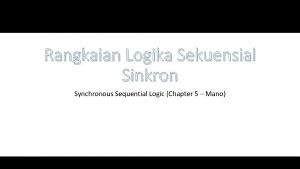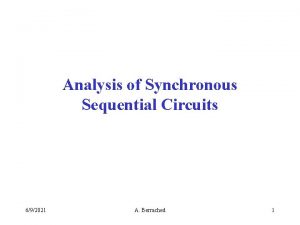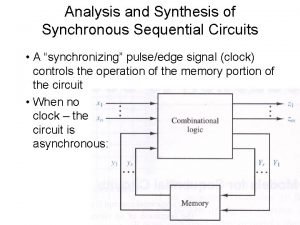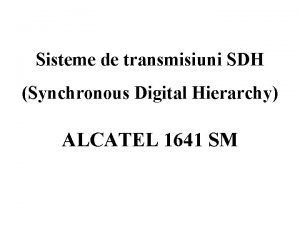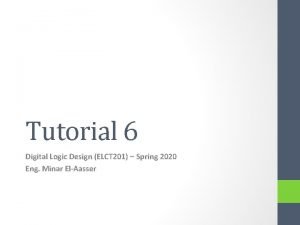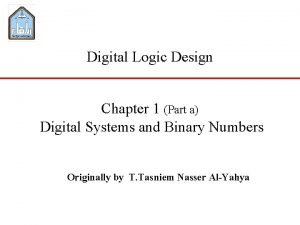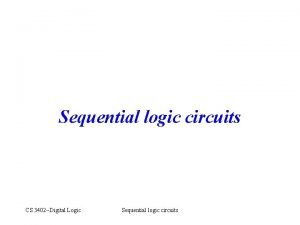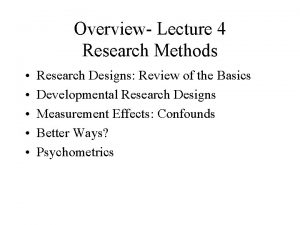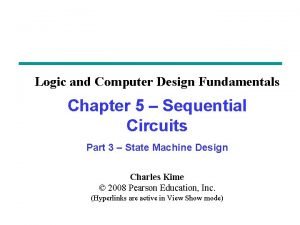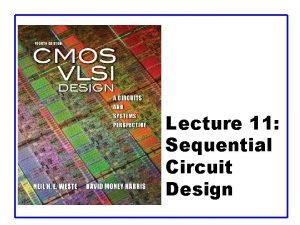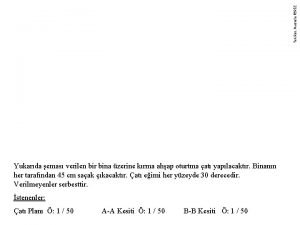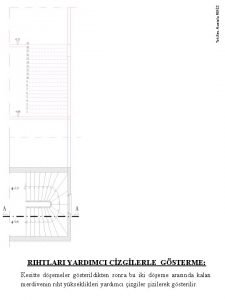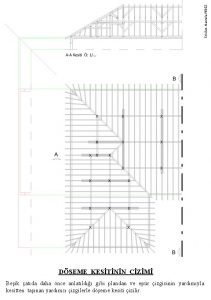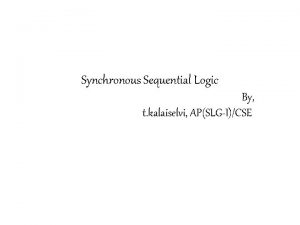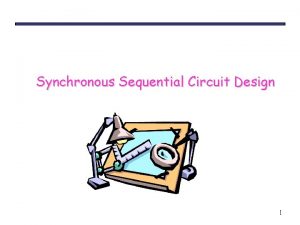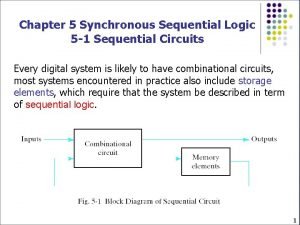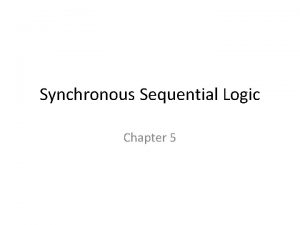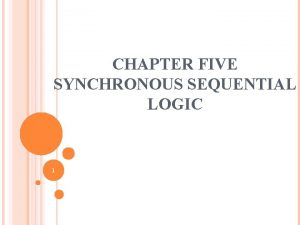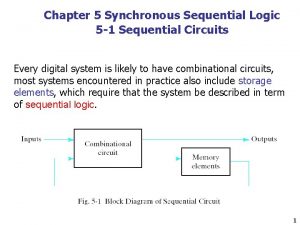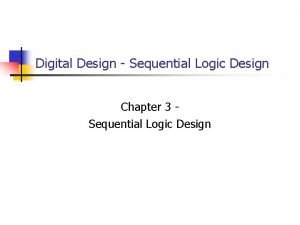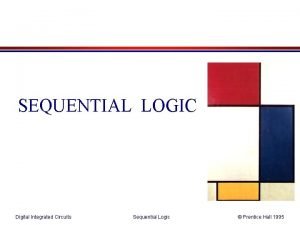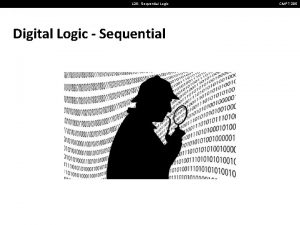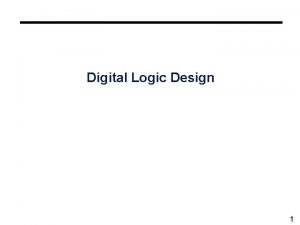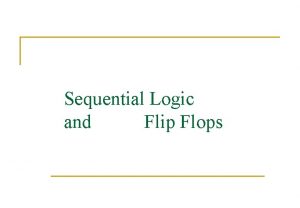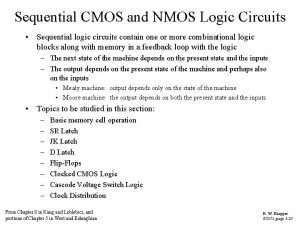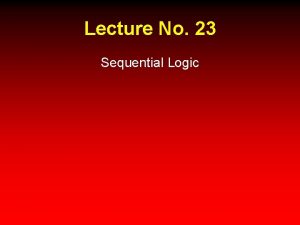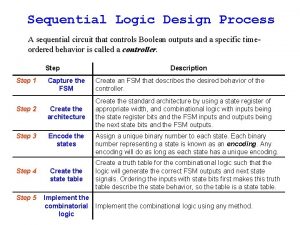Digital Logic Design I Synchronous Sequential Logic Mustafa







































































- Slides: 71

Digital Logic Design I Synchronous Sequential Logic Mustafa Kemal Uyguroğlu

Sequential Circuits « Asynchronous Inputs Combinational Circuit Outputs Memory Elements « Synchronous Inputs Outputs Combinational Circuit Clock Flip-flops 1

Latches « SR Latch S R Q 0 0 0 0 1 Q 0 Q’ 1 Q = Q 0 Initial Value Eastern Mediterranean University 2

Latches « SR Latch S R Q 0 0 0 1 0 0 Eastern Mediterranean University Q 0 1 Q’ 1 0 Q = Q 0 3

Latches « SR Latch 1 0 0 1 S 0 0 0 Eastern Mediterranean University R 0 0 1 Q 0 0 1 0 Q’ 1 0 1 Q = Q 0 Q=0 4

Latches « SR Latch 1 1 0 0 S 0 0 Eastern Mediterranean University R 0 0 1 1 Q 0 0 1 Q 0 1 0 0 Q’ 1 0 1 1 Q = Q 0 Q=0 5

Latches « SR Latch 0 1 0 S 0 0 1 R 0 0 1 1 0 Q 0 0 1 0 Q 0 1 0 0 1 Q’ 1 0 1 1 0 Q = Q 0 Q=1 1 Eastern Mediterranean University 6

Latches « SR Latch 0 1 1 S 0 0 1 1 R 0 0 1 1 0 0 Q 0 0 1 0 1 Q 0 1 0 0 1 1 Q’ 1 0 1 1 0 0 Q = Q 0 Q=1 Q=1 0 Eastern Mediterranean University 7

Latches « SR Latch 1 1 0 S 0 0 1 1 1 R 0 0 1 1 0 0 1 Q 0 0 1 0 1 0 Q 0 1 0 0 1 1 0 Q’ 1 0 1 1 0 0 0 Q = Q 0 Q=1 Q = Q’ 10 Eastern Mediterranean University 8

Latches « SR Latch 1 1 10 S 0 0 1 1 R 0 0 1 1 Q 0 0 1 0 1 Q 0 1 0 0 1 1 0 0 Q’ 1 0 1 1 0 0 Q = Q 0 Q=1 Q = Q’ 0 Eastern Mediterranean University 9

Latches « SR Latch S R Q Q 0 No change Reset 0 Set 1 Invalid Q=Q’=0 0 0 1 1 0 1 S 0 0 1 1 Q R Invalid 0 Q=Q’=1 Set 1 1 Reset 0 0 Q 0 No change 1 Eastern Mediterranean University 10

Latches « SR Latch S R 0 0 1 1 0 1 S’ R’ 0 0 1 1 0 1 Eastern Mediterranean University Q Q 0 No change Reset 0 Set 1 Invalid Q=Q’=0 Q Invalid Q=Q’=1 Set 1 Reset 0 Q 0 No change 11

Controlled Latches « SR Latch with Control Input C S R 0 1 1 x 0 1 Q Q 0 0 1 Q=Q’ No change Reset Set Invalid Eastern Mediterranean University 12

Controlled Latches « D Latch (D = Data) Timing Diagram C D Q t C D 0 x 1 0 1 1 Q Q 0 0 1 No change Reset Set Eastern Mediterranean University Output may change 13

Controlled Latches « D Latch (D = Data) Timing Diagram C D Q C D 0 x 1 0 1 1 Q Q 0 0 1 No change Reset Set Eastern Mediterranean University Output may change 14

Flip-Flops « Controlled latches are level-triggered C « Flip-Flops are edge-triggered CLK Positive Edge CLK Negative Edge Eastern Mediterranean University 15

Flip-Flops « Master-Slave D Flip-Flop D D C D Latch (Master) Q D C D Latch (Slave) Master CLK Q Q Slave CLK D Looks like it is negative edge-triggered QMaster QSlave Eastern Mediterranean University 16

Flip-Flops « Edge-Triggered D Flip-Flop D Q Q Positive Edge D Q Q Negative Edge Eastern Mediterranean University 17

Flip-Flops « JK Flip-Flop J Q K Q D = JQ’ + K’Q Eastern Mediterranean University 18

Flip-Flops « T Flip-Flop T J K Q D T Q Q Q T D = JQ’ + K’Q D = TQ’ + T’Q = T Q Eastern Mediterranean University Q Q 19

Flip-Flop Characteristic Tables D Q Q J Q K Q T Q Q D 0 1 J 0 0 1 1 T 0 1 Q(t+1) 0 1 Reset Set K Q(t+1) 0 Q(t) 1 0 0 1 1 Q’(t) No change Reset Set Toggle Q(t+1) Q(t) Q’(t) No change Toggle Eastern Mediterranean University 20

Flip-Flop Characteristic Equations D Q Q J Q K Q T Q Q D 0 1 J 0 0 1 1 Q(t+1) 0 1 K Q(t+1) 0 Q(t) 1 0 0 1 1 Q’(t) T 0 1 Q(t+1) Q(t) Q’(t) Eastern Mediterranean University Q(t+1) = D Q(t+1) = JQ’ + K’Q Q(t+1) = T Q 21

Flip-Flop Characteristic Equations « Analysis / Derivation J K Q Q J 0 0 1 1 K Q(t) Q(t+1) 0 0 1 1 1 0 0 0 1 1 Eastern Mediterranean University No change Reset Set Toggle 22

Flip-Flop Characteristic Equations « Analysis / Derivation J K Q Q J 0 0 1 1 K Q(t) Q(t+1) 0 0 1 1 1 0 0 0 0 1 1 Eastern Mediterranean University No change Reset Set Toggle 23

Flip-Flop Characteristic Equations « Analysis / Derivation J K Q Q J 0 0 1 1 K Q(t) Q(t+1) 0 0 1 1 1 0 1 1 Eastern Mediterranean University No change Reset Set Toggle 24

Flip-Flop Characteristic Equations « Analysis / Derivation J K Q Q J 0 0 1 1 K Q(t) Q(t+1) 0 0 1 1 1 0 1 1 1 0 Eastern Mediterranean University No change Reset Set Toggle 25

Flip-Flop Characteristic Equations « Analysis / Derivation J Q K Q J 0 0 1 1 K Q(t) Q(t+1) 0 0 1 1 1 0 1 1 1 0 K 0 J 1 1 1 0 0 0 1 Q Q(t+1) = JQ’ + K’Q Eastern Mediterranean University 26

Flip-Flops with Direct Inputs « Asynchronous Reset D Q R’ 0 D CLK Q(t+1) x x 0 Q R Reset Eastern Mediterranean University 27

Flip-Flops with Direct Inputs « Asynchronous Reset D Q Q R R’ 0 1 1 D CLK Q(t+1) x x 0 ↑ 0 0 ↑ 1 1 Reset Eastern Mediterranean University 28

Flip-Flops with Direct Inputs « Asynchronous Preset and Clear Preset PR D Q PR’ CLR’ D CLK Q(t+1) 1 0 x x 0 Q CLR Reset Eastern Mediterranean University 29

Flip-Flops with Direct Inputs « Asynchronous Preset and Clear Preset PR D Q PR’ CLR’ D CLK Q(t+1) 1 0 x x 0 1 x 1 Q CLR Reset Eastern Mediterranean University 30

Flip-Flops with Direct Inputs « Asynchronous Preset and Clear Preset PR D Q Q CLR PR’ CLR’ D CLK Q(t+1) 1 0 x x 0 1 x 1 ↑ 1 1 0 0 ↑ 1 1 Reset Eastern Mediterranean University 31

Analysis of Clocked Sequential Circuits « The State ● State = Values of all Flip-Flops Example AB=00 Eastern Mediterranean University 32

Analysis of Clocked Sequential Circuits « State Equations A(t+1) = DA = A(t) x(t)+B(t) x(t) =Ax+Bx B(t+1) = DB = A’(t) x(t) = A’ x y(t) = [A(t)+ B(t)] x’(t) = (A + B) x’ Eastern Mediterranean University 33

Analysis of Clocked Sequential Circuits « State Table (Transition Table) Present Input State A 0 0 1 1 B 0 0 1 1 t x 0 1 0 1 Next State A 0 0 0 1 0 1 t+1 B 0 1 0 0 Output y 0 0 1 0 1 0 t A(t+1) = A x + B x B(t+1) = A’ x y(t) = (A + B) x’ Eastern Mediterranean University 34

Analysis of Clocked Sequential Circuits « State Table (Transition Table) Present State A 0 0 1 1 t B 0 1 Next State Output x=0 x=1 A 0 0 B 0 0 A 0 1 1 1 t+1 B 1 1 0 0 y 0 1 1 1 y 0 0 t A(t+1) = A x + B x B(t+1) = A’ x y(t) = (A + B) x’ Eastern Mediterranean University 35

Analysis of Clocked Sequential Circuits « State Diagram Present State input/output AB 0/0 1/0 0/1 00 Next State x=0 Output x=1 x=0 x=1 A B A B y y 0 0 0 1 1 1 0 0 0 1 0 1 1 0 0 1 0 10 0/1 1/0 0/1 01 1/0 11 1/0 Eastern Mediterranean University 36

Analysis of Clocked Sequential Circuits « D Flip-Flops Example: Present Input State A 0 0 1 1 x 0 0 1 1 y 0 1 0 1 Next State A 0 1 1 0 0 1 x y D CLK Q A(t+1) = DA = A x y 01, 10 00, 11 0 1 00, 11 01, 10 Eastern Mediterranean University 37

Analysis of Clocked Sequential Circuits « JK Flip-Flops Example: Present Next I/P State A B x A B Flip-Flop Inputs JA KA JB KB 0 0 1 0 0 0 1 0 1 1 1 0 0 1 1 0 0 1 1 1 0 0 0 1 1 1 1 1 0 0 0 JA = B JB = x’ KA = B x’ KB = A x A(t+1) = JA Q’A + K’A QA = A’B + AB’ + Ax B(t+1) = JB Q’B + K’B QB = B’x’ + ABx + A’Bx’ Eastern Mediterranean University 38

Analysis of Clocked Sequential Circuits « JK Flip-Flops Example: Present Next I/P State A B x A B Flip-Flop Inputs JA KA JB KB 0 0 1 0 0 0 1 0 1 1 1 0 0 1 1 0 0 1 1 1 0 0 0 1 1 1 1 1 0 0 0 1 11 00 0 0 01 Eastern Mediterranean University 0 10 1 1 39

Analysis of Clocked Sequential Circuits « T Flip-Flops Example: Present Next F. F I/P O/P State Inputs A B x A B TA TB y 0 0 0 0 0 1 0 1 0 0 1 1 1 0 1 0 0 0 0 1 1 1 0 1 1 1 0 0 1 TA = B x y =AB TB = x A(t+1) = TA Q’A + T’A QA = AB’ + Ax’ + A’Bx 0 1 B(t+1) = TB Q’B + T’B QB 1 1 =x B Eastern Mediterranean University 40

Analysis of Clocked Sequential Circuits « T Flip-Flops Example: Present Next F. F I/P O/P State Inputs A B x A B TA TB y 0 0 0 0 0 1 0 1 0 0 1 1 1 0 1 0 0 0 0 1 1 1 0 0 1 1 0 0 1 1 1 0/0 00 1/0 01 1/1 0/1 1/0 11 Eastern Mediterranean University 10 1/0 0/0 41

Mealy and Moore Models « The Mealy model: the outputs are functions of both the present state and inputs (Fig. 5 -15). ● The outputs may change if the inputs change during the clock pulse period. ♦ The outputs may have momentary false values unless the inputs are synchronized with the clocks. « The Moore model: the outputs are functions of the present state only (Fig. 5 -20). ● The outputs are synchronous with the clocks. Eastern Mediterranean University 42

Mealy and Moore Models Fig. 5. 21 Block diagram of Mealy and Moore state machine Eastern Mediterranean University 43

Mealy and Moore Models Mealy Present State A B 0 0 0 1 0 1 1 1 1 I/P x 0 1 0 1 Moore Next O/P State A B y 0 0 1 0 0 0 1 1 0 0 Present State A B 0 0 0 1 0 1 1 1 1 For the same state, state the output changes with the input I/P x 0 1 0 1 Next O/P State A B y 0 0 1 0 0 1 1 1 0 0 1 For the same state, state the output does not change with the input Eastern Mediterranean University 44

Moore State Diagram State / Output 0 0 1 00/0 01/0 1 1 11/1 10/0 1 0 0 Eastern Mediterranean University 45

State Reduction and Assignment « State Reductions on the number of flip-flops and the number of gates. ● A reduction in the number of states may result in a reduction in the number of flip-flops. ● An example state diagram showing in Fig. 5. 25 State diagram Eastern Mediterranean University 46

State Reduction State: a a b c d e f f g a Input: 0 1 0 1 1 0 0 Output: 0 0 0 1 1 0 0 ● Only the input-output sequences are important. ● Two circuits are equivalent ♦ Have identical outputs for all input sequences; ♦ The number of states is not important. Fig. 5. 25 State diagram Eastern Mediterranean University 47

« Equivalent states ● Two states are said to be equivalent ♦ For each member of the set of inputs, they give exactly the same output and send the circuit to the same state or to an equivalent state. ♦ One of them can be removed. Eastern Mediterranean University 48

« Reducing the state table ● e = g (remove g); ● d = f (remove f); Eastern Mediterranean University 49

● The reduced finite state machine State: a a b c d e d e a Input: 0 1 0 1 1 0 0 Output: 0 0 0 1 1 0 0 Eastern Mediterranean University 50

● The checking of each pair of states for possible equivalence can be done systematically using Implication Table. ● The unused states are treated as don't-care condition Þ fewer combinational gates. Fig. 5. 26 Reduced State diagram Eastern Mediterranean University 51

Implication Table « The state-reduction procedure for completely specified state tables is based on the algorithm that two states in a state table can be combined into one if they can be shown to be equivalent. There are occasions when a pair of states do not have the same next states, but, nonetheless, go to equivalent next states. Consider the following state table: « (a, b) imply (c, d) and (c, d) imply (a, b). Both pairs of states are equivalent; i. e. , a and b are equivalent as well as c and d. Eastern Mediterranean University 52

Implication Table « The checking of each pair of states for possible equivalence in a table with a large number of states can be done systematically by means of an implication table. This a chart that consists of squares, one for every possible pair of states, that provide spaces for listing any possible implied states. Consider the following state table: Eastern Mediterranean University 53

Implication Table « The implication table is: Eastern Mediterranean University 54

Implication Table « On the left side along the vertical are listed all the states defined in the state table except the last, and across the bottom horizontally are listed all the states except the last. « The states that are not equivalent are marked with a ‘x’ in the corresponding square, whereas their equivalence is recorded with a ‘√’. « Some of the squares have entries of implied states that must be further investigated to determine whether they are equivalent or not. « The step-by-step procedure of filling in the squares is as follows: 1. Place a cross in any square corresponding to a pair of states whose outputs are not equal for every input. 2. Enter in the remaining squares the pairs of states that are implied by the pair of states representing the squares. We do that by starting from the top square in the left column and going down and then proceeding with the next column to the right. Eastern Mediterranean University 55

Implication Table 3. Make successive passes through the table to determine whether any additional squares should be marked with a ‘x’. A square in the table is crossed out if it contains at least one implied pair that is not equivalent. 4. Finally, all the squares that have no crosses are recorded with check marks. The equivalent states are: (a, b), (d, e), (d, g), (e, g). We now combine pairs of states into larger groups of equivalent states. The last three pairs can be combined into a set of three equivalent states (d, e, g) because each one of the states in the group is equivalent to the other two. The final partition of these states consists of the equivalent states found from the implication table, together with all the remaining states in the state table that are not equivalent to any other state: (a, b) (c) (d, e, g) (f) The reduced state table is: Eastern Mediterranean University 56

Implication Table Eastern Mediterranean University 57

State Assignment « To minimize the cost of the combinational circuits. ● Three possible binary state assignments. (m states need n-bits, where 2 n > m) Eastern Mediterranean University 58

● Any binary number assignment is satisfactory as long as each state is assigned a unique number. ● Use binary assignment 1. Eastern Mediterranean University 59

Design Procedure « Design Procedure for sequential circuit ● The word description of the circuit behavior to get a state diagram; ● State reduction if necessary; ● Assign binary values to the states; ● Obtain the binary-coded state table; ● Choose the type of flip-flops; ● Derive the simplified flip-flop input equations and output equations; ● Draw the logic diagram; Eastern Mediterranean University 60

Design of Clocked Sequential Circuits « Example: Detect 3 or more consecutive 1’s 1 0 S 0 / 0 S 1 / 0 0 0 1 0 S 3 / 1 1 S 2 / 0 State A B S 0 0 0 S 1 0 1 S 2 1 0 S 3 1 1 1 Eastern Mediterranean University 61

Design of Clocked Sequential Circuits « Example: Detect 3 or more consecutive 1’s Present Input State A 0 0 1 1 B 0 0 1 1 x 0 1 0 1 Next State A 0 0 0 1 0 1 B 0 1 0 0 0 1 Output y 0 0 0 1 1 1 0 S 0 / 0 S 1 / 0 0 S 3 / 1 1 Eastern Mediterranean University 1 S 2 / 0 1 62

Design of Clocked Sequential Circuits « Example: Detect 3 or more consecutive 1’s Present Input State A 0 0 1 1 B 0 0 1 1 x 0 1 0 1 Next State A 0 0 0 1 0 1 B 0 1 0 0 0 1 Output y 0 0 0 1 1 Synthesis using D Flip-Flops A(t+1) = DA (A, B, x) = ∑ (3, 5, 7) B(t+1) = DB (A, B, x) = ∑ (1, 5, 7) y (A, B, x) = ∑ (6, 7) Eastern Mediterranean University 63

Design of Clocked Sequential Circuits with D F. F. « Example: Detect 3 or more consecutive 1’s Synthesis using D Flip-Flops DA (A, B, x) = ∑ (3, 5, 7) =Ax+Bx DB (A, B, x) = ∑ (1, 5, 7) B 0 0 1 0 A 0 1 1 0 x 0 1 0 0 = A x + B’ x y (A, B, x) = ∑ (6, 7) =AB B B A 0 1 1 0 x 0 0 A 0 0 1 1 x Eastern Mediterranean University 64

Design of Clocked Sequential Circuits with D F. F. « Example: Detect 3 or more consecutive 1’s Synthesis using D Flip-Flops DA = A x + B x DB = A x + B’ x y =AB Eastern Mediterranean University 65

Flip-Flop Excitation Tables Present Next State Q(t) Q(t+1) 0 0 0 1 1 F. F. Input D 0 1 Present Next State F. F. Input Q(t) Q(t+1) J K 0 x 0 0 1 x 0 1 1 0 x 1 1 1 x 0 Q(t) Q(t+1) 0 0 0 1 1 0 0 (No change) 0 1 (Reset) 1 0 (Set) 1 1 (Toggle) 0 1 (Reset) 1 1 (Toggle) 0 0 (No change) 1 0 (Set) T 0 1 1 0 Eastern Mediterranean University 66

Design of Clocked Sequential Circuits with JK F. F. « Example: Detect 3 or more consecutive 1’s Present Input State A 0 0 1 1 B 0 0 1 1 x 0 1 0 1 Next State A 0 0 0 1 0 1 Flip-Flop Inputs B JA 0 0 1 0 x 1 x KA x x 1 0 JB KB 0 x 1 x 1 0 x 1 x 0 Synthesis using JK F. F. JA (A, B, x) = ∑ (3) d. JA (A, B, x) = ∑ (4, 5, 6, 7) KA (A, B, x) = ∑ (4, 6) d. KA (A, B, x) = ∑ (0, 1, 2, 3) JB (A, B, x) = ∑ (1, 5) d. JB (A, B, x) = ∑ (2, 3, 6, 7) KB (A, B, x) = ∑ (2, 3, 6) d. KB (A, B, x) = ∑ (0, 1, 4, 5) Eastern Mediterranean University 67

Design of Clocked Sequential Circuits with JK F. F. « Example: Detect 3 or more consecutive 1’s Synthesis using JK Flip-Flops B JA = B x KA = x’ JB = x KB = A’ + x’ B 0 0 1 0 x x A x x x B 0 1 x x A 1 0 0 1 x B x x 1 1 A 0 1 x x x A x x 0 1 x Eastern Mediterranean University 68

Design of Clocked Sequential Circuits with T F. F. « Example: Detect 3 or more consecutive 1’s Present Input State A 0 0 1 1 B 0 0 1 1 x 0 1 0 1 Next State A 0 0 0 1 0 1 B 0 1 0 0 0 1 F. F. Input TA 0 0 0 1 1 0 TB 0 1 1 1 0 Synthesis using T Flip-Flops TA (A, B, x) = ∑ (3, 4, 6) TB (A, B, x) = ∑ (1, 2, 3, 5, 6) Eastern Mediterranean University 69

Design of Clocked Sequential Circuits with T F. F. « Example: Detect 3 or more consecutive 1’s Synthesis using T Flip-Flops TA = A x’ + A’ B x TB = A’ B + B x B B 0 0 1 1 1 A 1 0 0 1 x A 0 1 x Eastern Mediterranean University 70
 Concurrent vs sequential
Concurrent vs sequential 캠블리 단점
캠블리 단점 Combinational logic sequential logic
Combinational logic sequential logic Combinational logic sequential logic 차이
Combinational logic sequential logic 차이 Combinational logic sequential logic
Combinational logic sequential logic Contoh rangkaian sekuensial
Contoh rangkaian sekuensial Jelaskan pengertian dari synchronous sequential system
Jelaskan pengertian dari synchronous sequential system Analysis of synchronous sequential circuits
Analysis of synchronous sequential circuits Analysis of synchronous sequential circuits
Analysis of synchronous sequential circuits Synchronous digital system
Synchronous digital system Pdh sdh
Pdh sdh Digital logic design tutorial
Digital logic design tutorial Digital system design
Digital system design Digital logic design practice problems
Digital logic design practice problems Digital logic design lectures
Digital logic design lectures Digital logic design
Digital logic design What is a nonserual sequential logic in project
What is a nonserual sequential logic in project What is a nonserual sequential logic in project
What is a nonserual sequential logic in project Programmable device
Programmable device S r q logic
S r q logic D ff excitation table
D ff excitation table Cohort effects definition
Cohort effects definition Disadvantages of small n design
Disadvantages of small n design Cross sequential design
Cross sequential design Trimentum
Trimentum Sequential circuit design
Sequential circuit design Sequential design example
Sequential design example Sequential circuit design
Sequential circuit design State table reduction
State table reduction First order logic vs propositional logic
First order logic vs propositional logic First order logic vs propositional logic
First order logic vs propositional logic Third order logic
Third order logic Cryptarithmetic problem logic+logic=prolog
Cryptarithmetic problem logic+logic=prolog Dr mustafa shakir
Dr mustafa shakir Mustafa bulut ymm
Mustafa bulut ymm Threads consumes cpu in best possible manner
Threads consumes cpu in best possible manner Protein enerji malnütrisyonu
Protein enerji malnütrisyonu Mustafa beğen
Mustafa beğen Nanoelektronik
Nanoelektronik Amina mustafa
Amina mustafa Mustafa erol deu
Mustafa erol deu Mustafa ipteş
Mustafa ipteş Mustafa kemal seslense
Mustafa kemal seslense Mustafa şahin endokrinoloji
Mustafa şahin endokrinoloji Hatay mustafa kemal üni yatay geçiş
Hatay mustafa kemal üni yatay geçiş Polüri
Polüri Dr mustafa gözen
Dr mustafa gözen Marwan hassan mustafa
Marwan hassan mustafa Khalid mustafa
Khalid mustafa Mustafa shakir contacts
Mustafa shakir contacts Radyoterap
Radyoterap Peygamberimizin merhametli ve affedici oluşu
Peygamberimizin merhametli ve affedici oluşu Dr mustafa shakir
Dr mustafa shakir Mustafa akpınar gib
Mustafa akpınar gib Mustafa periz
Mustafa periz Görünüş
Görünüş Kırma çatı kesiti
Kırma çatı kesiti Dr mustafa mete
Dr mustafa mete Mustafa ahmet beler
Mustafa ahmet beler Vesiletü'n necat mesnevi mi
Vesiletü'n necat mesnevi mi Prof. dr. mustafa serdar genç
Prof. dr. mustafa serdar genç Dere yatağına ev yapan mustafa bey
Dere yatağına ev yapan mustafa bey Mustafa kemal'in çocukluk dönemi ve öğrenim hayatı
Mustafa kemal'in çocukluk dönemi ve öğrenim hayatı Dr mustafa shakir
Dr mustafa shakir Mustafa emre ilal
Mustafa emre ilal Mustafa sezer pehlivan
Mustafa sezer pehlivan Mustafa altınışık idrar
Mustafa altınışık idrar Tropik hormon örnekleri
Tropik hormon örnekleri Sana sphere
Sana sphere Mustafa uckun los angeles
Mustafa uckun los angeles Dr mustafa oglu
Dr mustafa oglu Ymm mustafa soydemir
Ymm mustafa soydemir






